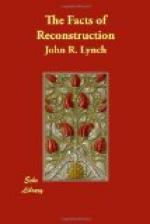That the State never had before, and has never had since, a finer Judiciary than that which was organized under the administration of Governor Alcorn and which continued under the administration of Governor Ames is an indisputable and incontrovertible fact. The Judges of the Supreme Court were E.G. Peyton, H.F. Simrall and J. Tarbell, who in Mississippi had no superiors in their profession, and who had the respect and confidence of the bar and of the people without regard to race or politics. Judge Peyton was the Chief Justice, Simrall and Tarbell being the Associate Justices. The first two were old residents of the State, while Mr. Justice Tarbell was what the Democrats would call a “Carpet Bagger.” But that he was an able lawyer and a man of unimpeachable integrity no one doubted or questioned. During the second administration of President Grant he held the important position of Second Comptroller of the United States Treasury. The Circuit Court bench was graced with such able and brilliant lawyers as Jason Niles, G.C. Chandler, George F. Brown, J.A. Orr, John W. Vance, Robert Leachman, B.B. Boone, Orlando Davis, James M. Smiley, Uriah Millsaps, William M. Hancock, E.S. Fisher, C.C. Shackleford, W.B. Cunningham, W.D. Bradford and A. Alderson. Judges Brown and Cunningham were the only ones in the above list who were not old residents of the State. After leaving the bench, Judge Chandler served for several years as United States Attorney. Judge Niles served one term as a member of Congress, having been elected as a Republican in 1875. His son Henry Clay Niles is now United States District Judge for the State, having been appointed to that important position by President Harrison. He was strongly recommended by many members of the bench and bar of the State; and the very able and creditable way in which he has discharged the duties of the position has more than demonstrated the wisdom of the selection.
The Chancery Courts as organized by Governor Alcorn and continued by Governor Ames were composed of men no less able and brilliant than those who composed the Bench of the Circuit Courts. They were: J.C. Lyon, E.P. Harmon, E.G. Peyton, Jr., J.M. Ellis, G.S. McMillan, Samuel Young, W.G. Henderson, Edwin Hill, T.R. Gowan, J.F. Simmons, Wesley Drane, D.W. Walker, DeWitte Stearns, D.P. Coffee, E.W. Cabiness, A.E. Reynolds, Thomas Christian, Austin Pollard, J.J. Hooker, O.H. Whitfield, E. Stafford, W.A. Drennan, Thomas Walton, E.H. Osgood, C.A. Sullivan, Hiram Cassedy, Jr., W.B. Peyton, J.D. Barton, J.J. Dennis, W.D. Frazee, P.P. Bailey, L.C. Abbott, H.W. Warren, R. Boyd, R.B. Stone, William Breck, J.N. Campbell, H.R. Ware and J.B. Deason. The above names composed those who were appointed both by Governors Alcorn and Ames. A majority of those originally appointed by Governor Alcorn were reappointed by Governor Ames. Of the forty appointments of Judges of the Chancery Courts made under the administrations of Alcorn and Ames, not more than about seven were not to the “manner born.” The administration of James L. Alcorn as Governor of the State of Mississippi is one of the best with which that unfortunate State has been blessed. A more extended reference to the subsequent administration of Governor Ames will be made in a later chapter.




